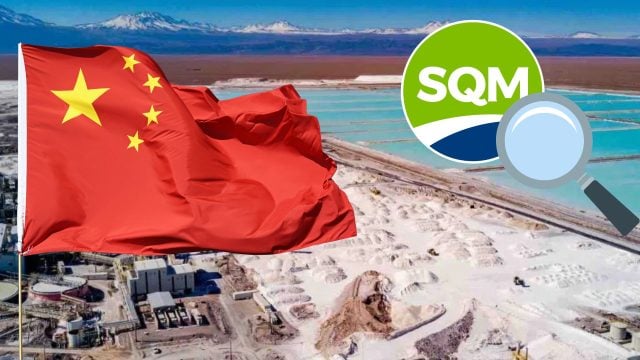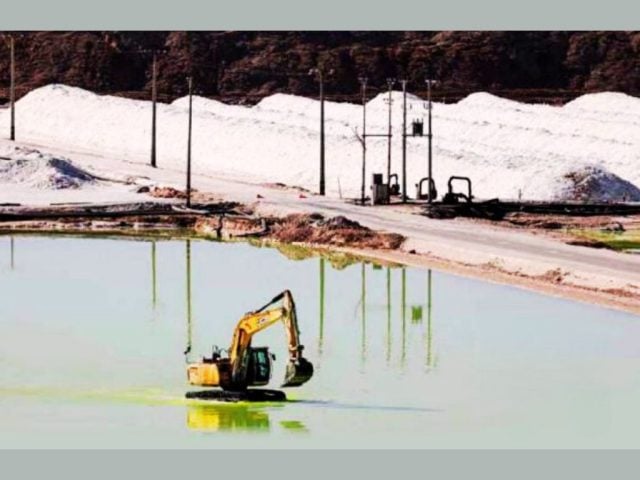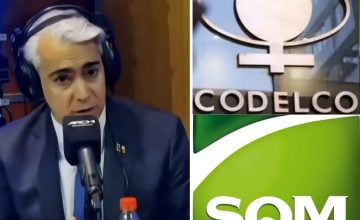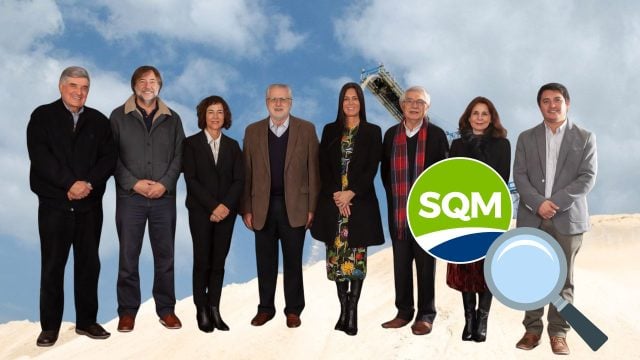Original article: China establece condiciones para el acuerdo SQM-Codelco por riesgos de concentración en el mercado del litio
The Chinese antitrust authority imposes a rigorous 10-year oversight on the SQM-Codelco lithium merger, requiring stable prices and guaranteed supply volumes for clients in the Asian country.
By Bruno Sommer
In a decision reflecting the delicate balance of attracting investments while safeguarding strategic interests, the State Administration for Market Regulation of China (SAMR) has conditionally approved the formation of a joint venture between Chile’s state mining company Codelco and chemical producer SQM. This conditional approval, announced this week, comes with a stringent corrective measures package designed to mitigate competition risks associated with the operation in the critical lithium carbonate import market.
The Chinese regulator determined that the merger, which will consolidate the lithium assets of both companies into a single entity, “could restrict competition” in China. The primary concern is SQM’s already overwhelming market share in China’s lithium carbonate imports, which fluctuated between 45% and 70% from 2021 to 2024. By merging with Codelco, which has significant untapped lithium projects, the new entity would enhance its market power, posing the risk of distorting prices and supply for China’s battery industry.
Measures to Safeguard the Supply Chain
In light of this risk, the SAMR opted not to block the operation but rather to subject it to prolonged and detailed supervision. The commitments agreed upon with the companies will extend over a decade, primarily aiming to protect Chinese manufacturers from potential abuses of dominant market positions.
The imposed conditions are predominantly behavioral and require the new joint venture to:
- Honor existing contracts with Chinese customers.
- Ensure a minimum annual supply of lithium carbonate, maintaining a continuous flow of the material to China.
- Adhere to a maximum price cap, linked to a percentage of a benchmark market price, to prevent arbitrary price hikes.
- Maintain independent competition, prohibiting the exchange of confidential information between the joint venture and its parent companies or other market players.
- Report compliance with these conditions to the SAMR every six months.
According to the official announcement, these measures “will mitigate the risks of coordination and supply disruptions in the lithium market.”
A Decision Based on Strategic Dependency
The SAMR analysis clearly illustrates the rationale behind the decision: China needs Chilean lithium. The document acknowledges that the country has a “rigid demand” for imported lithium carbonate, of which Chile has been the primary source, accounting for between 75% and 90% of China’s imports in recent years.
With a rapidly expanding electric vehicle and energy storage industry, Beijing cannot afford disruptions in the flow of this critical material. Blocking the operation could have created friction and potentially affected future access. Instead, the strategy has been to approve it, but with regulatory constraints ensuring that the needs of its domestic industry are protected.
Thus, the agreement, which significantly cedes a substantial part of the lithium business to the successors of Pinochet, is on the brink of being established. It remains to be seen what the Comptroller Dorothy Pérez will say, who has requested the contracts between state-owned Codelco and Morgan Stanley.
FULL TEXT
Announcement by the State Administration for Market Regulation Regarding Antitrust Review Decision on the Conditional Approval for the Establishment of a New Joint Venture between the National Copper Corporation of Chile and Sociedad Química y Minera de Chile
Publication date: 2025-11-10 15:30 Source: Second Antitrust Enforcement Department
The State Administration for Market Regulation (hereinafter referred to as “the Regulatory Authority”) received the notification of economic concentration for the establishment of a new joint venture (hereinafter referred to as “the Operation”) between the National Copper Corporation of Chile (hereinafter referred to as “Codelco”) and the Chemical and Mining Company of Chile (hereinafter referred to as “SQM”). After review, the Regulatory Authority decided to approve this economic concentration subject to compliance with restrictive conditions. In accordance with Article 36 of the Anti-Monopoly Law of the People’s Republic of China (hereinafter referred to as “the Anti-Monopoly Law”), the following is announced:
I. Admission and Review Procedure
On October 22, 2024, the Regulatory Authority received the notification of economic concentration for this case. After examining it, it found the documentation presented to be incomplete and requested the notifying parties to supplement it. On January 7, 2025, the Regulatory Authority confirmed that the supplemented documentation met the requirements set forth in Article 28 of the Anti-Monopoly Law, admitting the notification and initiating preliminary review. On January 27, the authority decided to proceed with an additional review of this economic concentration. On April 24, with the consent of the notifying parties, it decided to extend the deadline for the additional review. On June 12, the Regulatory Authority decided to suspend the review period for this case, resuming it on November 6. Currently, the case is in the phase of extending the additional review, with a deadline until November 15, 2025. The Regulatory Authority considers that this concentration has or could have exclusionary or restrictive effects on competition in the Chinese imported lithium carbonate market.
During the review process, the Regulatory Authority sought opinions from relevant government departments, industry associations, competitors, and customers in the value chain, collecting information on the definition of the relevant market, market structure, sector characteristics, and the impacts of the concentration on various aspects, while verifying the authenticity, integrity, and accuracy of the documents and materials submitted by the notifying parties.
II. Basic Situation of the Case
Part of Joint Venture 1: Codelco. Established in Chile in 1976, it mainly engages in businesses related to copper and associated by-products, holding licenses and exploitation rights for lithium projects such as the Maricunga and Pedernales salt flats.
Part of Joint Venture 2: SQM. Established in Chile in 1968, it is listed on the Santiago Stock Exchange and the New York Stock Exchange, with a dispersed shareholding structure and no final controller. It primarily produces and sells chemicals related to lithium, iodine, potassium, etc.
In May 2024, Codelco and SQM entered into an agreement to establish a joint venture, through which both parties intend to form a joint entity by injecting assets. Prior to the transaction, SQM operates the mining project in the Atacama Salt Flat in Chile, mainly supplying lithium products, with exploitation rights expiring at the end of 2030; Codelco holds the relevant rights for this mining project from 2031 to 2060. Once the transaction is completed, Codelco and SQM will jointly control the joint venture, which will continue operating the mining project.
III. Relevant Market
Following the review, it was determined that the joint venture will operate in the lithium carbonate and lithium hydroxide businesses, with horizontal overlap between SQM and Codelco.
(A) Market for Imported Lithium Carbonate: Lithium is the first metallic element of the periodic table and the lightest metal, with the highest specific capacity and a strong ability to gain/lose electrons among all metals, making it ideal for battery manufacture. Lithium carbonate and lithium hydroxide are the primary lithium compounds. Lithium carbonate is mainly used in the production of lithium iron phosphate batteries and low-nickel ternary batteries, as well as in the production of floor treatments, cement densifiers, bipolar disorder medications, etc. To meet the lithium resource deficit, China needs to import lithium carbonate. Imports mainly come from salt flats in Chile, Argentina, etc., with lower integrated production costs, while domestic production of lithium carbonate, mainly from smelting imported lithium concentrates or national resources, has higher integrated production costs. When there is a shortfall in the demand for imported lithium carbonate, national lithium carbonate products are unlikely to replace it entirely. Therefore, this case defines imported lithium carbonate as a separate relevant goods market.
(B) Market for Lithium Hydroxide: Lithium hydroxide is an inorganic compound mainly used in the production of high-nickel ternary batteries, and also as a thickener for lubricants, CO2 absorbent in spaceships and submarines, and corrosion inhibitor in nuclear reactors. The production capacity of lithium hydroxide in China is sufficient, the import volume is small, and the export scale is large, so it is not necessary to further subdivide it based on product origin. Thus, this case defines lithium hydroxide as a separate relevant goods market.
(B) Relevant Geographical Market
The relevant geographical market for imported lithium carbonate is defined as the territory of China. The consumption of lithium resources in China exceeds domestic production, there is a rigid demand for imported lithium carbonate, and there are no political or transportation barriers to the circulation of these products within the country.
The relevant geographical market for lithium hydroxide is defined as global. The main suppliers of lithium hydroxide compete on a global scale, and there are no significant obstacles to the global circulation of these products.
IV. Competition Analysis
According to Article 33 of the Anti-Monopoly Law and with reference to the “Guidelines for the Review of Horizontal Economic Concentrations,” the Regulatory Authority conducted an in-depth analysis of the impact of this concentration on market competition, considering the market share and control power of participants in the relevant market, the level of concentration in the relevant market, and the impact on end users and other relevant operators. It concluded that this concentration has or could have exclusionary or restrictive effects on competition in the Chinese imported lithium carbonate market.
(A) China has a significant deficit in lithium resources, with a rigid demand for imported lithium carbonate, mainly from Chile.
The global lithium industrial chain is primarily divided into three links: “mining – processing of lithium salts – processing of battery materials.” The relevant industry in China is primarily concentrated on the processing of lithium salts (such as lithium carbonate and lithium hydroxide) and battery materials, and is relatively insufficient in upstream mining. According to statistics from relevant industry associations, approximately 60% of China’s lithium raw materials in 2024 came from imports. In recent years, China has needed to import lithium carbonate, spodumene concentrate, etc., to meet internal lithium resource deficits. The main source of lithium carbonate imports is Chile, accounting for between 75%-80% (2021), 85%-90% (2022), 85%-90% (2023), and 75%-80% (2024) of China’s imports.
(B) The transaction will further strengthen the control power of the post-concentration entity in the Chinese imported lithium carbonate market.
From 2021 to 2024, SQM was the largest supplier of imported lithium carbonate in China, with market shares in the Chinese imported lithium carbonate market of 45%-50%, 50%-55%, 65%-70%, and 50%-55%, respectively. Besides the Atacama Salt Flat project (which will be operated by the joint venture post-transaction), SQM also possesses the operational Mount Holland project in Australia and over ten untapped lithium projects. Codelco holds licenses and exploitation rights for lithium projects like the Maricunga and Pedernales salt flats in Chile. While these projects may not yet be operational, they will become an effective offering in the future. The transaction will integrate the resources and technologies of both parties, weakening competition between SQM and Codelco and reinforcing the control power of the post-concentration entity in the Chinese imported lithium carbonate market. In recent years, China’s lithium battery industry has developed rapidly, increasing customer demand for lithium carbonate. Simultaneously, China’s imports of lithium carbonate primarily come from products extracted from salt flats in Chile, Argentina, etc. Preparations for exploiting salt flats are complex, making market entry difficult.
(C) The transaction will increase the potential for coordinated conduct in the Chinese imported lithium carbonate market.
Lithium carbonate is a commodity, with third-party institutions periodically publishing price information, which provides high transparency to the market. The structure of the Chinese imported lithium carbonate market is relatively stable; since 2021, the combined market share of the top three suppliers exceeded 75%, and the number of market operators is not high with small cost differentials. Moreover, lithium mining projects require high initial investments, and large mining companies can establish joint ventures to develop specific projects, creating numerous business connections. The transaction will strengthen business ties among major competitors in the Chinese imported lithium carbonate market, potentially generating coordination effects.
V. Negotiation of Restrictive Conditions
During the review, the Regulatory Authority timely informed the notifying parties of its opinion that the case had or could have exclusionary or restrictive effects on competition, and maintained several rounds of negotiations with them on how to mitigate the adverse impacts of this economic concentration on competition. The Regulatory Authority evaluated the restrictive commitment plans proposed by the notifying parties, focusing on their effectiveness, feasibility, and timeliness, in accordance with the “Provisions for the Review of Economic Concentrations.”
After evaluation, the Regulatory Authority considers that the plan of restrictive commitments presented by the notifying parties on November 6, 2025 (see Annex) can effectively mitigate the adverse impacts of this economic concentration on competition.
VI. Review Decision
Given that this economic concentration has or could have effects of exclusion or restriction of competition in the Chinese imported lithium carbonate market, and based on the plan of restrictive commitments presented by the notifying parties, the Regulatory Authority decides to approve this concentration subject to compliance with restrictive conditions, requiring both parties to the concentration and the post-concentration entity to fulfill the following obligations:
(A) Continue to comply with and execute the obligations and all business terms under existing contracts with Chinese customers, unless the customer substantially breaches its contractual obligations or the contract terminates as agreed.
(B) Continue supplying relevant products to Chinese customers based on principles of fairness, reasonableness, and non-discrimination, without denying, restricting, or delaying supply, or imposing unreasonable transaction conditions; unless there is a situation of insufficient demand, the annual supply volume will not be less than a certain level [Confidential Information]; the annual average price will not exceed a certain percentage of the benchmark market price [Confidential Information].
(C) In case of significant changes in supply, make reasonable efforts to continue supplying lithium carbonate products to Chinese customers, establishing a special task force to resolve the issue, and reporting to the Regulatory Authority on the situation and providing solutions.
(D) Maintain independent competition between the parties of the joint venture, the joint venture, and other operators in the lithium market, and, except as required by law, not exchange confidential information that could affect market decisions.
(E) [Confidential Information].
The execution and monitoring of the above restrictive conditions will be carried out in accordance with the provisions of this announcement. The plan of restrictive commitments presented by the notifying parties to the Regulatory Authority on November 6, 2025, is legally binding for both parties to the transaction and the post-concentration entity. From the effective date, the parties to the transaction and the post-concentration entity will report to the Regulatory Authority every six months on compliance with this commitment plan until the restrictive conditions expire. These commitments will be effective for 10 years from the closing date of this concentration, automatically terminating once the term expires.
The Regulatory Authority has the right to supervise compliance with the previous obligations by the notifying parties, either through a supervisory trustee or by its own means. If the notifying parties fail to comply or violate the previous obligations, the Regulatory Authority will act in accordance with the relevant provisions of the Anti-Monopoly Law.
This decision comes into force on the date of its announcement.
State Administration for Market Regulation
November 7, 2025











